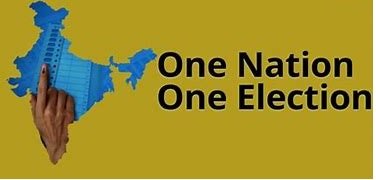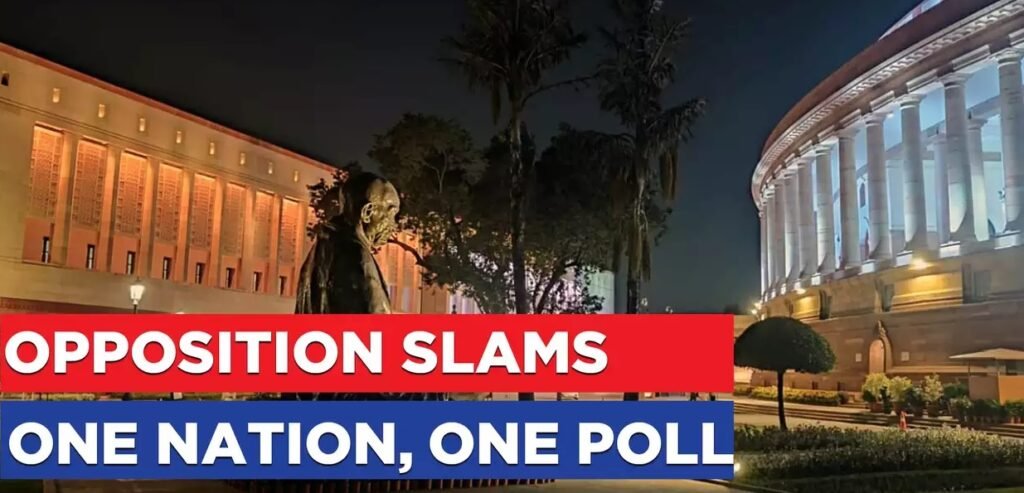India’s democratic framework is standing on the pillars of its robust electoral process, enabling citizens to actively participate and shape governance at all three-level ranging from parliament to panchayats. Since independence, over 400 elections to the Lok Sabha and State Legislative Assemblies have showcased the Election Commission of India’s commitment to fairness and transparency towards the citizens of India. However, the fragmented and frequent nature of elections has sparked discussions on the need for a more efficient system. This has led to the resurgence of interest in the concept of “One Nation One Election.”
The concept of “One Nation One Election” proposes the synchronization of elections for the Lok Sabha and State Legislative Assemblies to streamline the electoral process, reduce costs, and ensure better governance. This would allow voters to cast their ballots for both tiers of government on the same day in their constituencies, though voting could still occur in phases across the country.
The High-Level Committee Report on Simultaneous Elections in India, released in 2024, provided a comprehensive roadmap for implementing this vision. Its recommendations were accepted by the Union Cabinet on 18th September 2024, Then the Bill was introduced in the Lok Sabha by Union Law Minister Arjun Ram Meghwal on December 17, 2024. This is a key reform requiring thoughtful deliberation and consensus therefore After consultation, the bill has been referred to a Joint Parliamentary Committee for further deliberations
This idea, while appealing in theory, has its own set of challenges and implications. In this blog, we will explore the history of this concept, its pros and cons, the perspectives of various political analysts, and the way forward.

Table of Contents
Historical Background for One nation One Election
The concept of simultaneous elections is not a new idea in India. Following the independence of India, The first general elections to the Lok Sabha and State Assemblies were held together in 1951-52, a practice that continued for three subsequent general elections in 1957, 1962, and 1967.
However, this cycle of synchronized elections was disrupted in 1968 and 1969 due to the premature dissolution of some State Legislative Assemblies. The Fourth Lok Sabha was also dissolved prematurely in 1970, with fresh elections held in 1971. Unlike the First, Second, and Third Lok Sabha, which completed their full five-year terms, the Fifth Lok Sabha’s term was extended until 1977 because of the declaration of Emergency. Since then, only a few Lok Sabha terms have lasted the full five years.
State Assemblies have faced similar disruptions over the years. Premature dissolutions and term extensions have become a recurring challenge. These developments have firmly disrupted the cycle of simultaneous elections, leading to the current pattern of staggered electoral schedules across the country.
The concept of “One Nation One Election” was revived in recent years, with the current government advocating for its implementation. The idea was also discussed in the following reports which played a significant role in shaping the discourse around “One Nation One Election” in India.: –
Law Commission of India (1999)
The 170th report of the Law Commission discussed the feasibility of simultaneous elections to the Lok Sabha and State Legislative Assemblies. It highlighted the benefits of reducing election costs and ensuring administrative efficiency.
Election Commission of India (1983)
The Election Commission’s report in 1983 also touched upon the idea of simultaneous elections, emphasizing the need for a more streamlined electoral process. The Election Commission’s report in 1983 also touched upon the idea of simultaneous elections, emphasizing the need for a more streamlined electoral process.
NITI Aayog on One nation One Election (2017)
The NITI Aayog, a policy think tank of the Government of India, released a discussion paper on simultaneous elections. The paper outlined the potential benefits and challenges, advocating for a phased approach to implementation.
High-Level Committee on One nation One Election (2023-2024)

The High-Level Committee on Simultaneous Elections, headed by former President Ram Nath Kovind, was constituted by the Government of India on 2nd September 2023. Its primary objective was to explore the feasibility of conducting simultaneous elections for the Lok Sabha and State Legislative Assemblies. The committee solicited extensive public and political feedback and consulted with experts to analyze the potential benefits and challenges associated with this proposed electoral reform.
The committee’s report, submitted in March 2024. Key Takeaways of the committee’s report:
Public Response
The Committee received over 21,500 responses, with 80% in favor of simultaneous elections.
Responses from Political Parties
47 political parties submitted their views. Of these, 32 parties supported simultaneous elections, citing benefits like resource optimization and social harmony. 15 parties raised concerns about potential anti-democratic effects and marginalization of regional parties.
Expert Consultations and Economic Impact
The Committee consulted Former Chief Justices of India, Former Election Commissioners, and legal experts. Business organizations like CII, FICCI, and ASSOCHAM supported the proposal, highlighting the positive impact on economic stability by reducing disruptions and costs associated with election cycles.
Phased wise Approach to Implementation
The Committee recommended implementing simultaneous elections in two phases:
Phase 1: Synchronizing Lok Sabha and State Legislative Assemblies elections.
Phase 2: Synchronizing elections for Municipalities and Panchayats with Lok Sabha and State Legislative elections within 100 days.
Electoral Roll and EPIC/Voter ID number Harmonization
The Committee highlighted inefficiencies in electoral roll preparation by State Election Commissions and recommended creating a Single Electoral Roll and Single EPIC for all three tiers of government. This would reduce duplication and errors, safeguarding voter rights.
Rationale for One nation One Election
The points below are based on the findings of the report issued by the High-Level Committee on Simultaneous Elections, headed by former President Ram Nath Kovind:
Promotes Consistency in Governance
Due to the ongoing cycle of elections in various parts of the country, political parties, their leaders, legislators, and both State and Central Governments often focus their efforts on preparing for upcoming elections rather than prioritizing governance. The adoption of simultaneous elections would refocus the government’s attention towards developmental activities and the implementation of policies aimed at promoting the welfare of the masses.
The ongoing cycle of elections across the country diverts attention from good governance. Political parties focus more on election-related activities to secure victories, leaving less time for development and essential governance.
Prevents Policy Paralysis
The implementation of the Model Code of Conduct during elections disrupts routine administrative activities and developmental initiatives which also restricts the government’s ability to announce new policies and projects. This disruption not only hampers the progress of vital welfare schemes but also leads to governance uncertainty. Holding simultaneous elections would mitigate the prolonged enforcement of the MCC, thereby reducing policy paralysis and enabling continuous governance
Mitigates Resource Diversion
The deployment of a substantial number of personnel for election duties, such as polling officials and civil servants, can lead to significant diversion of resources from their core responsibilities. With elections conducted simultaneously, the need for frequent deployment would diminish, allowing government officials and public institutions to focus more on their primary roles rather than election-related tasks.
Enhances Political Opportunities
Conducting elections simultaneously entails a more equitable allocation of political opportunities and responsibilities within political parties. Currently, it is not uncommon for certain leaders within a party to dominate the electoral landscape, contesting elections at multiple levels and monopolizing key positions. In the scenario of simultaneous elections, there arises greater scope for diversification and inclusivity among political workers representing various parties, allowing a wider range of leaders to emerge and contribute to the democratic process.
Reduced Financial Burden
Conducting simultaneous elections could significantly cut down the financial costs associated with multiple election cycles by government and political parties and ultimately save the nation’s resources.
The costs associated with deploying security forces, setting up polling booths, and other logistical arrangements can be minimized. The economic benefits include a more efficient allocation of resources and better fiscal management, fostering a conducive environment for economic growth and investor confidence.
Enhanced Voter Turnout
With a single election cycle, voter fatigue can be reduced, potentially leading to higher voter turnout. This can strengthen the democratic process by ensuring broader participation.
Challenges of One Nation One Election
Logistical Challenges
Conducting simultaneous elections across a vast and diverse country like India poses significant logistical challenges. Ensuring the availability of adequate resources, including security personnel and polling staff and EVMs would be a daunting task. As per an estimate, the election commission would need 3 times of the EVMs of that they have right now.
Constitutional and Legal Hurdles
Implementing simultaneous elections would require amendments to the Constitution in Articles 82A and 324A and various electoral laws like the Representation of People’s Act. Achieving consensus among political parties and stakeholders on these amendments could be challenging.
Impact on Regional Parties after One nation One Election
Regional parties might find it difficult to compete with national parties in a simultaneous election scenario. The focus on national issues could overshadow regional concerns, affecting the electoral prospects of regional parties.
Disruption of Electoral Cycles
Synchronizing elections would require either extending or curtailing the terms of existing legislatures, which could be seen as undemocratic. This could lead to legal and political controversies.
Voter Confusion
With the current level of literacy in India, Simultaneous elections could lead to voter confusion, as they would have to vote for both national and state representatives at the same time. This might affect the quality of voting decisions.
Perspectives of Political Pundits
Political analysts have diverse opinions on the concept of “One Nation One Election.” Those who are in power at union government argue that it is a necessary reform to streamline the electoral process and ensure better governance. They believe that the benefits of cost efficiency, reduced disruption, and enhanced voter turnout outweigh the challenges.

Others, mainly the opposition parties along with regional parties, however, caution against the potential risks. They highlight the logistical and constitutional hurdles, the impact on regional parties, and the disruption of electoral cycles as significant concerns.
Some analysts also argue that simultaneous elections could lead to a centralization of power, undermining the federal structure of India as governments and political parties are on continuous check due to the frequent elections in the country.
READ OUR COMPREHENSIVE BLOG ON UNIFIED PENSION SCHEME
Way Forward for One nation One Election
The High-Level Committee on Simultaneous Elections, led by former President Ram Nath Kovind, has laid the groundwork for a transformative shift in India’s electoral process. By aligning the election cycles of the Lok Sabha and State Legislative Assemblies, the committee’s recommendations promise to address longstanding challenges associated with frequent elections, such as governance disruptions and resource wastage.
For now, the Constitution amendment bill is with the standing committee till then we need to wait whether one nation one election would become the law of the land, or it is just one another Jumla or political stunt.
Join us for more informative blogs like this.

